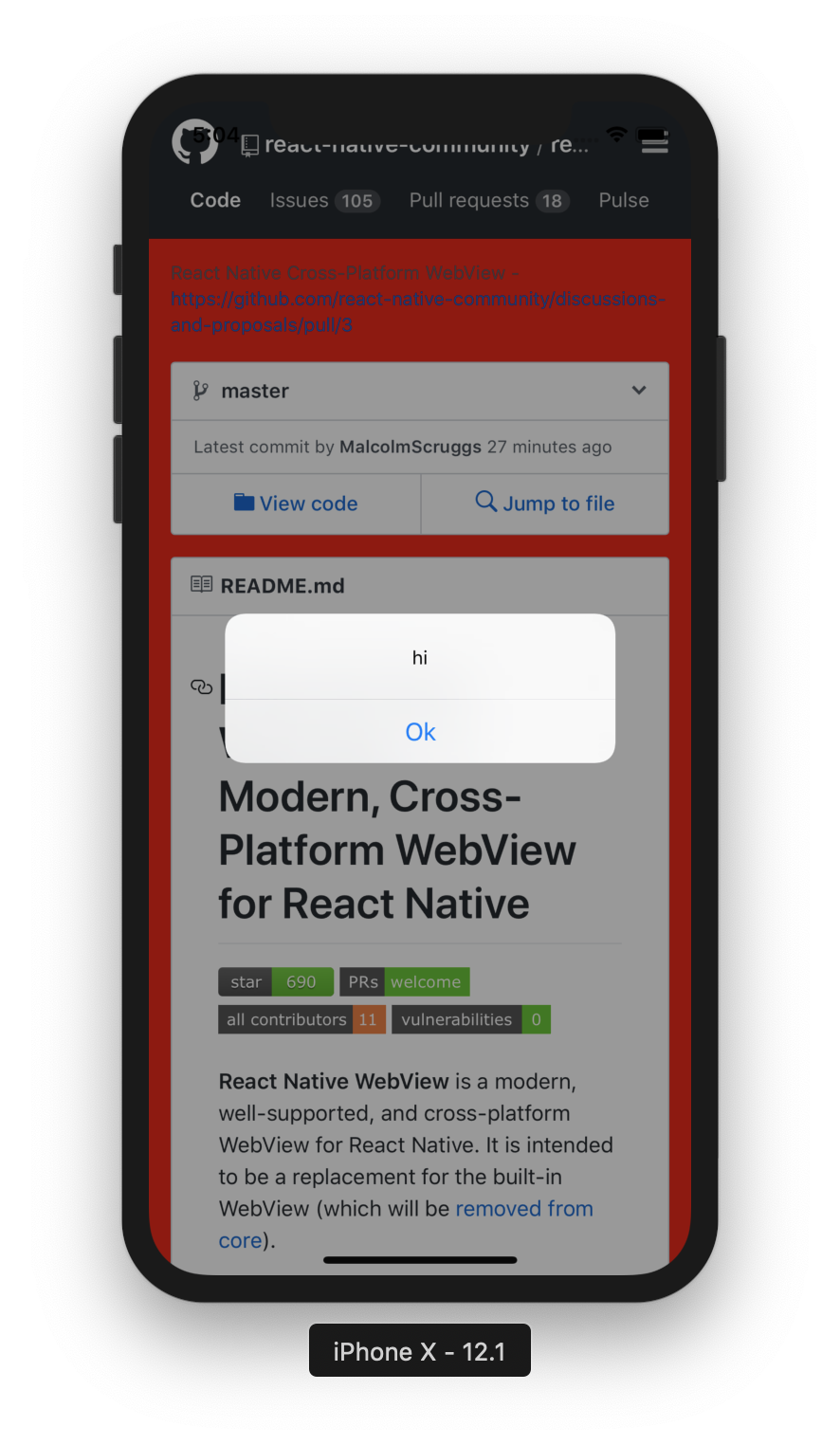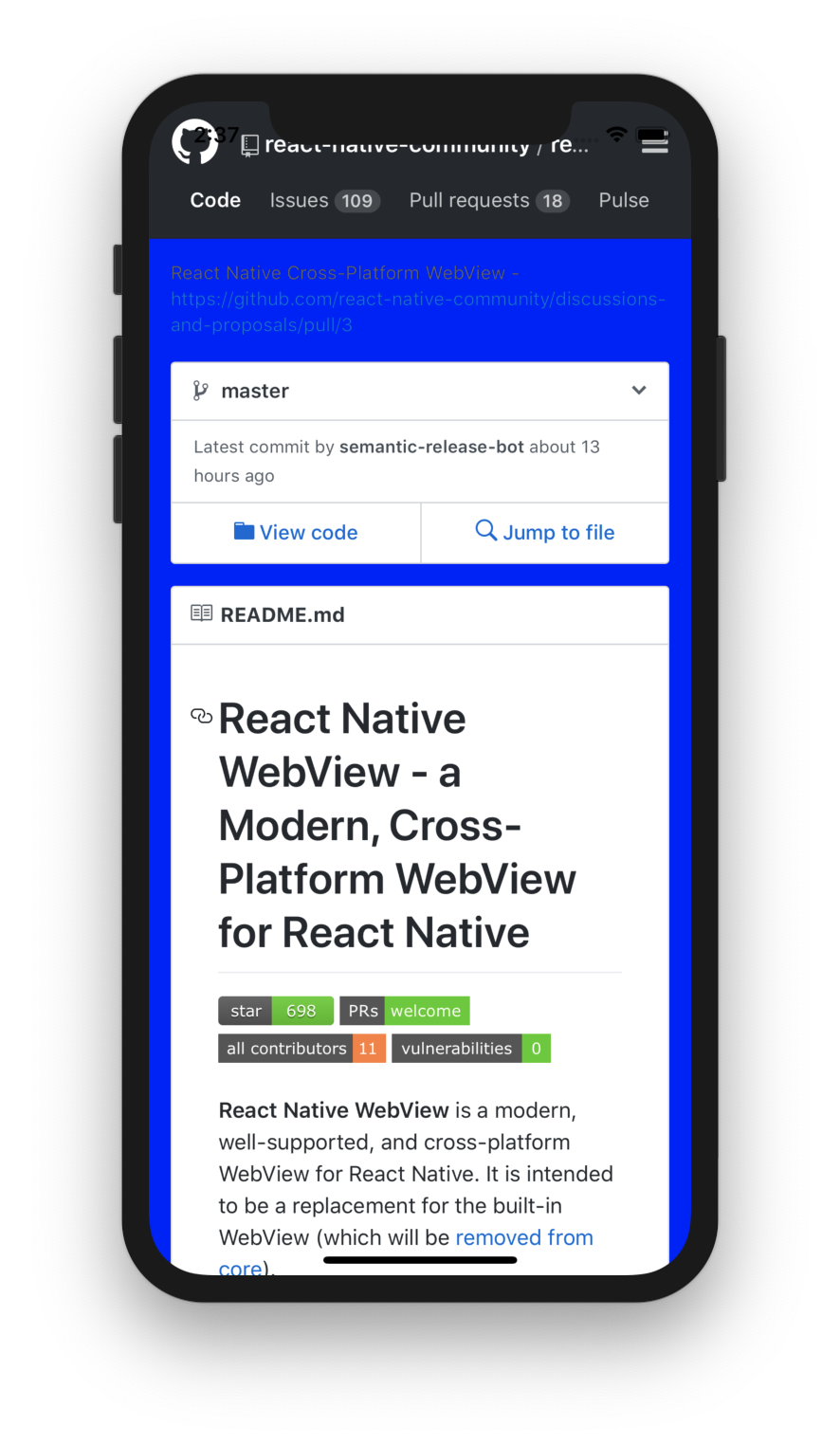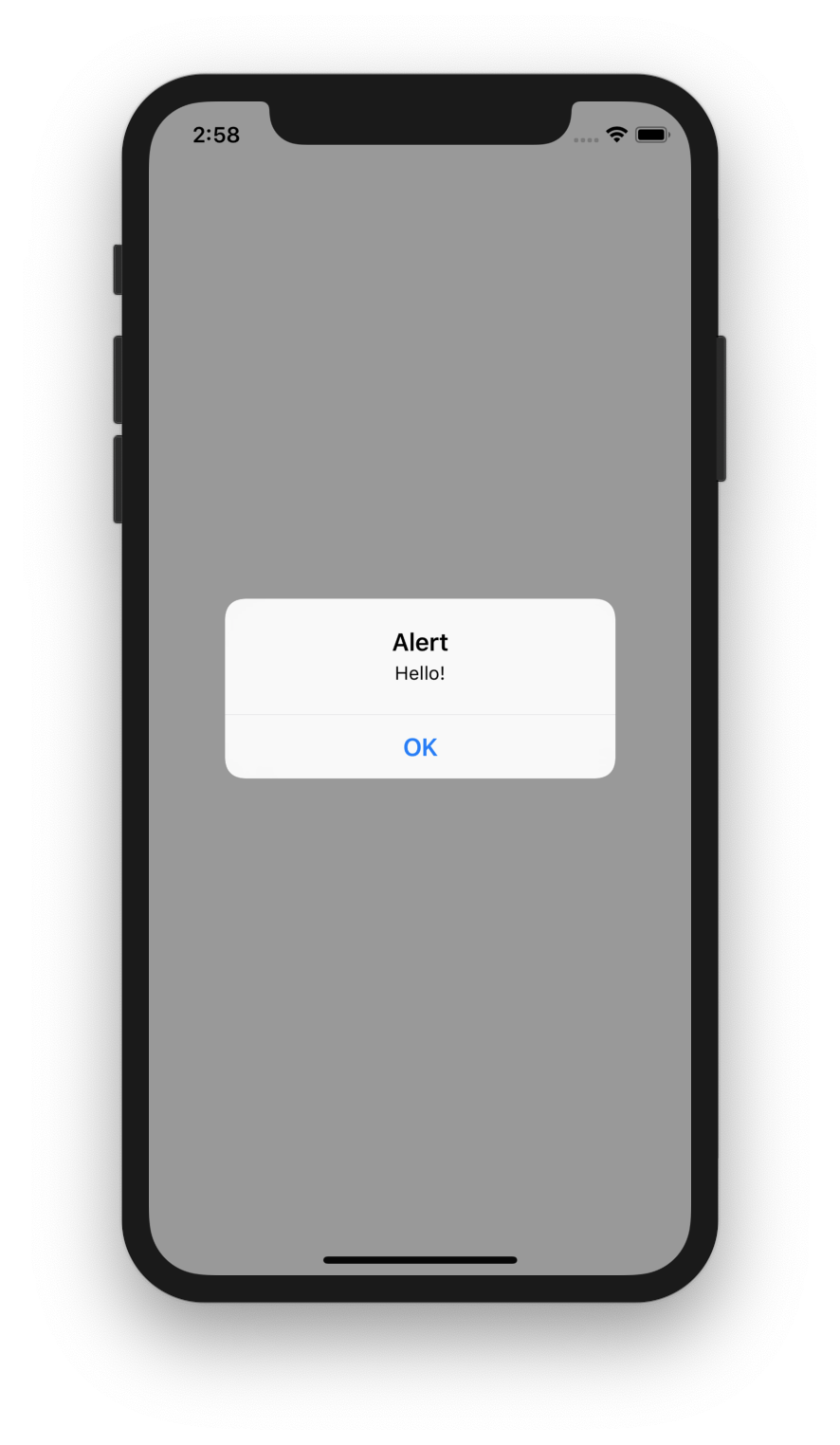This document walks you through the most common use cases for React Native WebView. It doesn't cover the full API, but after reading it and looking at the sample code snippets you should have a good sense for how the WebView works and common patterns for using the WebView.
This guide is currently a work in progress.
- Basic Inline HTML
- Basic URL Source
- Loading local HTML files
- Controlling navigation state changes
- Add support for File Upload
- Multiple files upload
- Add support for File Download
- Communicating between JS and Native
- Working with custom headers, sessions, and cookies
The simplest way to use the WebView is to simply pipe in the HTML you want to display. Note that setting an html source requires the originWhiteList property to be set to ['*'].
import React, { Component } from 'react';
import { WebView } from 'react-native-webview';
class MyInlineWeb extends Component {
render() {
return (
<WebView
originWhitelist={['*']}
source={{ html: '<h1>This is a static HTML source!</h1>' }}
/>
);
}
}Passing a new static html source will cause the WebView to rerender.
This is the most common use-case for WebView.
import React, { Component } from 'react';
import { WebView } from 'react-native-webview';
class MyWeb extends Component {
render() {
return <WebView source={{ uri: 'https://reactnative.dev/' }} />;
}
}Note: This is currently not working as discussed in #428 and #518. Possible workarounds include bundling all assets with webpack or similar, or running a local webserver.
Show non-working method
Sometimes you would have bundled an HTML file along with the app and would like to load the HTML asset into your WebView. To do this on iOS and Windows, you can just import the html file like any other asset as shown below.
import React, { Component } from 'react';
import { WebView } from 'react-native-webview';
const myHtmlFile = require('./my-asset-folder/local-site.html');
class MyWeb extends Component {
render() {
return <WebView source={myHtmlFile} />;
}
}However on Android, you need to place the HTML file inside your android project's asset directory. For example, if local-site.html is your HTML file and you'd like to load it into the webview, you should move the file to your project's android asset directory which is your-project/android/app/src/main/assets/. Then you can load the html file as shown in the following code block
import React, { Component } from 'react';
import { WebView } from 'react-native-webview';
class MyWeb extends Component {
render() {
return (
<WebView source={{ uri: 'file:///android_asset/local-site.html' }} />
);
}
}Sometimes you want to intercept a user tapping on a link in your webview and do something different than navigating there in the webview. Here's some example code on how you might do that using the onNavigationStateChange function.
import React, { Component } from 'react';
import { WebView } from 'react-native-webview';
class MyWeb extends Component {
webview = null;
render() {
return (
<WebView
ref={(ref) => (this.webview = ref)}
source={{ uri: 'https://reactnative.dev/' }}
onNavigationStateChange={this.handleWebViewNavigationStateChange}
/>
);
}
handleWebViewNavigationStateChange = (newNavState) => {
// newNavState looks something like this:
// {
// url?: string;
// title?: string;
// loading?: boolean;
// canGoBack?: boolean;
// canGoForward?: boolean;
// }
const { url } = newNavState;
if (!url) return;
// handle certain doctypes
if (url.includes('.pdf')) {
this.webview.stopLoading();
// open a modal with the PDF viewer
}
// one way to handle a successful form submit is via query strings
if (url.includes('?message=success')) {
this.webview.stopLoading();
// maybe close this view?
}
// one way to handle errors is via query string
if (url.includes('?errors=true')) {
this.webview.stopLoading();
}
// redirect somewhere else
if (url.includes('google.com')) {
const newURL = 'https://reactnative.dev/';
const redirectTo = 'window.location = "' + newURL + '"';
this.webview.injectJavaScript(redirectTo);
}
};
}For iOS, all you need to do is specify the permissions in your ios/[project]/Info.plist file:
Photo capture:
<key>NSCameraUsageDescription</key>
<string>Take pictures for certain activities</string>
Gallery selection:
<key>NSPhotoLibraryUsageDescription</key>
<string>Select pictures for certain activities</string>
Video recording:
<key>NSMicrophoneUsageDescription</key>
<string>Need microphone access for recording videos</string>
Add permission in AndroidManifest.xml:
<manifest ...>
......
<!-- this is required only for Android 4.1-5.1 (api 16-22) -->
<uses-permission android:name="android.permission.WRITE_EXTERNAL_STORAGE" />
......
</manifest>If the file input indicates that images or video is desired with accept, then the WebView will attempt to provide options to the user to use their camera to take a picture or video.
Normally, apps that do not have permission to use the camera can prompt the user to use an external app so that the requesting app has no need for permission. However, Android has made a special exception for this around the camera to reduce confusion for users. If an app can request the camera permission because it has been declared, and the user has not granted the permission, it may not fire an intent that would use the camera (MediaStore.ACTION_IMAGE_CAPTURE or MediaStore.ACTION_VIDEO_CAPTURE). In this scenario, it is up to the developer to request camera permission before a file upload directly using the camera is necessary.
File Upload using <input type="file" /> is not supported for Android 4.4 KitKat (see details):
import { WebView } from "react-native-webview";
WebView.isFileUploadSupported().then(res => {
if (res === true) {
// file upload is supported
} else {
// not file upload support
}
});
You can control single or multiple file selection by specifing the multiple attribute on your input element:
// multiple file selection
<input type="file" multiple />
// single file selection
<input type="file" />
On iOS, you are going to have to supply your own code to download files. You can supply an onFileDownload callback
to the WebView component as a prop. If RNCWebView determines that a file download needs to take place, the URL where you can download the file
will be given to onFileDownload. From that callback you can then download that file however you would like to do so.
NOTE: iOS 13+ is needed for the best possible download experience. On iOS 13 Apple added an API for accessing HTTP response headers, which
is used to determine if an HTTP response should be a download. On iOS 12 or older, only MIME types that cannot be rendered by the webview will
trigger calls to onFileDownload.
Example:
onFileDownload = ({ nativeEvent }) => {
const { downloadUrl } = nativeEvent;
// --> Your download code goes here <--
};To be able to save images to the gallery you need to specify this permission in your ios/[project]/Info.plist file:
<key>NSPhotoLibraryAddUsageDescription</key>
<string>Save pictures for certain activities.</string>
On Android, integration with the DownloadManager is built-in. Add this permisison in AndroidManifest.xml (only required if your app supports Android versions lower than 10):
<manifest ...>
......
<!-- this is required to save files on Android versions lower than 10 -->
<uses-permission android:name="android.permission.WRITE_EXTERNAL_STORAGE" />
......
</manifest>You will often find yourself wanting to send messages to the web pages loaded by your webviews and also receiving messages back from those web pages.
To accomplish this, React Native WebView exposes three different options:
- React Native -> Web: The
injectedJavaScriptprop - React Native -> Web: The
injectJavaScriptmethod - Web -> React Native: The
postMessagemethod andonMessageprop
This is a script that runs immediately after the web page loads for the first time. It only runs once, even if the page is reloaded or navigated away.
import React, { Component } from 'react';
import { View } from 'react-native';
import { WebView } from 'react-native-webview';
export default class App extends Component {
render() {
const runFirst = `
document.body.style.backgroundColor = 'red';
setTimeout(function() { window.alert('hi') }, 2000);
true; // note: this is required, or you'll sometimes get silent failures
`;
return (
<View style={{ flex: 1 }}>
<WebView
source={{
uri:
'https://github.com/react-native-community/react-native-webview',
}}
onMessage={(event) => {}}
injectedJavaScript={runFirst}
/>
</View>
);
}
}This runs the JavaScript in the runFirst string once the page is loaded. In this case, you can see that both the body style was changed to red and the alert showed up after 2 seconds. An onMessage event is required as well to inject the JavaScript code into the WebView.
By setting injectedJavaScriptForMainFrameOnly: false, the JavaScript injection will occur on all frames (not just the main frame) if supported for the given platform. For example, if a page contains an iframe, the javascript will be injected into that iframe as well with this set to false. (Note this is not supported on Android.) There is also injectedJavaScriptBeforeContentLoadedForMainFrameOnly for injecting prior to content loading. Read more about this in the Reference.
Under the hood
On iOS,
– this is no longer true as of versioninjectedJavaScriptruns a method on WebView calledevaluateJavaScript:completionHandler:8.2.0. Instead, we use aWKUserScriptwith injection timeWKUserScriptInjectionTimeAtDocumentEnd. As a consequence,injectedJavaScriptno longer returns an evaluation value nor logs a warning to the console. In the unlikely event that your app depended upon this behaviour, please see migration steps here to retain equivalent behaviour. On Android,injectedJavaScriptruns a method on the Android WebView calledevaluateJavascriptWithFallback
This is a script that runs before the web page loads for the first time. It only runs once, even if the page is reloaded or navigated away. This is useful if you want to inject anything into the window, localstorage, or document prior to the web code executing.
import React, { Component } from 'react';
import { View } from 'react-native';
import { WebView } from 'react-native-webview';
export default class App extends Component {
render() {
const runFirst = `
window.isNativeApp = true;
true; // note: this is required, or you'll sometimes get silent failures
`;
return (
<View style={{ flex: 1 }}>
<WebView
source={{
uri:
'https://github.com/react-native-community/react-native-webview',
}}
injectedJavaScriptBeforeContentLoaded={runFirst}
/>
</View>
);
}
}This runs the JavaScript in the runFirst string before the page is loaded. In this case, the value of window.isNativeApp will be set to true before the web code executes.
By setting injectedJavaScriptBeforeContentLoadedForMainFrameOnly: false, the JavaScript injection will occur on all frames (not just the top frame) if supported for the given platform. However, although support for injectedJavaScriptBeforeContentLoadedForMainFrameOnly: false has been implemented for iOS and macOS, it is not clear that it is actually possible to inject JS into iframes at this point in the page lifecycle, and so relying on the expected behaviour of this prop when set to false is not recommended.
On iOS,
– this is no longer true as of versioninjectedJavaScriptBeforeContentLoadedruns a method on WebView calledevaluateJavaScript:completionHandler:8.2.0. Instead, we use aWKUserScriptwith injection timeWKUserScriptInjectionTimeAtDocumentStart. As a consequence,injectedJavaScriptBeforeContentLoadedno longer returns an evaluation value nor logs a warning to the console. In the unlikely event that your app depended upon this behaviour, please see migration steps here to retain equivalent behaviour. On Android,injectedJavaScriptruns a method on the Android WebView calledevaluateJavascriptWithFallbackNote on Android Compatibility: For applications targetingBuild.VERSION_CODES.Nor later, JavaScript state from an empty WebView is no longer persisted across navigations likeloadUrl(java.lang.String). For example, global variables and functions defined before callingloadUrl(java.lang.String)will not exist in the loaded page. Applications should use the Android Native APIaddJavascriptInterface(Object, String)instead to persist JavaScript objects across navigations.
While convenient, the downside to the previously mentioned injectedJavaScript prop is that it only runs once. That's why we also expose a method on the webview ref called injectJavaScript (note the slightly different name!).
import React, { Component } from 'react';
import { View } from 'react-native';
import { WebView } from 'react-native-webview';
export default class App extends Component {
render() {
const run = `
document.body.style.backgroundColor = 'blue';
true;
`;
setTimeout(() => {
this.webref.injectJavaScript(run);
}, 3000);
return (
<View style={{ flex: 1 }}>
<WebView
ref={(r) => (this.webref = r)}
source={{
uri:
'https://github.com/react-native-community/react-native-webview',
}}
/>
</View>
);
}
}After 3 seconds, this code turns the background blue:
Under the hood
On iOS,
injectJavaScriptcalls WebView'sevaluateJS:andThen:On Android,injectJavaScriptcalls Android WebView'sevaluateJavascriptWithFallbackmethod
Being able to send JavaScript to the web page is great, but what about when the web page wants to communicate back to your React Native code? This is where window.ReactNativeWebView.postMessage and the onMessage prop come in.
You must set onMessage or the window.ReactNativeWebView.postMessage method will not be injected into the web page.
window.ReactNativeWebView.postMessage only accepts one argument which must be a string.
import React, { Component } from 'react';
import { View } from 'react-native';
import { WebView } from 'react-native-webview';
export default class App extends Component {
render() {
const html = `
<html>
<head></head>
<body>
<script>
setTimeout(function () {
window.ReactNativeWebView.postMessage("Hello!")
}, 2000)
</script>
</body>
</html>
`;
return (
<View style={{ flex: 1 }}>
<WebView
source={{ html }}
onMessage={(event) => {
alert(event.nativeEvent.data);
}}
/>
</View>
);
}
}This code will result in this alert:
In React Native WebView, you can set a custom header like this:
<WebView
source={{
uri: 'http://example.com',
headers: {
'my-custom-header-key': 'my-custom-header-value',
},
}}
/>This will set the header on the first load, but not on subsequent page navigations.
In order to work around this, you can track the current URL, intercept new page loads, and navigate to them yourself (original credit for this technique to Chirag Shah from Big Binary):
const CustomHeaderWebView = (props) => {
const { uri, onLoadStart, ...restProps } = props;
const [currentURI, setURI] = useState(props.source.uri);
const newSource = { ...props.source, uri: currentURI };
return (
<WebView
{...restProps}
source={newSource}
onShouldStartLoadWithRequest={(request) => {
// If we're loading the current URI, allow it to load
if (request.url === currentURI) return true;
// We're loading a new URL -- change state first
setURI(request.url);
return false;
}}
/>
);
};
<CustomHeaderWebView
source={{
uri: 'http://example.com',
headers: {
'my-custom-header-key': 'my-custom-header-value',
},
}}
/>;You can set cookies on the React Native side using the @react-native-community/cookies package.
When you do, you'll likely want to enable the sharedCookiesEnabled prop as well.
const App = () => {
return (
<WebView
source={{ uri: 'http://example.com' }}
sharedCookiesEnabled={true}
/>
);
};If you'd like to send custom cookies in the WebView itself, you can do so in a custom header, like this:
const App = () => {
return (
<WebView
source={{
uri: 'http://example.com',
headers: {
Cookie: 'cookie1=asdf; cookie2=dfasdfdas',
},
}}
sharedCookiesEnabled={true}
/>
);
};Note that these cookies will only be sent on the first request unless you use the technique above for setting custom headers on each page load.
There are some inconsistencies in how the hardware silence switch is handled between embedded audio and video elements and between iOS and Android platforms.
Audio on iOS will be muted when the hardware silence switch is in the on position, unless the ignoreSilentHardwareSwitch parameter is set to true.
Video on iOS will always ignore the hardware silence switch.


